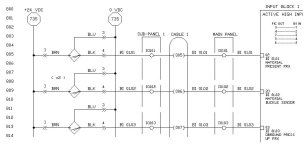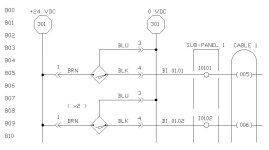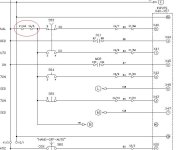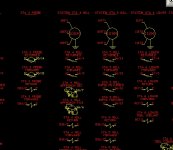TimothyMoulder
Member
I have a feeling this one will be contentious 
First, let's define what I mean by "DC Power" : 24-volt supply and common lines to sensors and solenoids. They don't get switched at any point by anything, and are always at the same voltage level throughout their run. They may be connected directly to the main panel, or via a sub-panel.
That said, I've seen many, many methods of documenting the run of DC power through a machine, from simply ignoring it to a separate number for each branch to each sub-panel. In fact, I can't recall seeing the same exact method twice!
So, let's discuss a few basics :
1. How important is it to document the precise run of the DC supply through the system? Given it's nature and purpose, as long as the wires are marked "+DC" and "0DC", does the conductor on the schematic really make a difference?
2. If it is critical, what's the best approach to documenting it? Should the run be lumped with the IO it supplies, or is a branching scheme (like mine) acceptable? Vertical ladder rails? What about those weird (to me, heh heh) "buss-bar" symbols?
Examples to follow
The "I know it's there" approach :
There is a variation of this one - the "Always One Wire Number" approach.
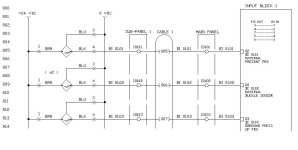
First, let's define what I mean by "DC Power" : 24-volt supply and common lines to sensors and solenoids. They don't get switched at any point by anything, and are always at the same voltage level throughout their run. They may be connected directly to the main panel, or via a sub-panel.
That said, I've seen many, many methods of documenting the run of DC power through a machine, from simply ignoring it to a separate number for each branch to each sub-panel. In fact, I can't recall seeing the same exact method twice!
So, let's discuss a few basics :
1. How important is it to document the precise run of the DC supply through the system? Given it's nature and purpose, as long as the wires are marked "+DC" and "0DC", does the conductor on the schematic really make a difference?
2. If it is critical, what's the best approach to documenting it? Should the run be lumped with the IO it supplies, or is a branching scheme (like mine) acceptable? Vertical ladder rails? What about those weird (to me, heh heh) "buss-bar" symbols?
Examples to follow
The "I know it's there" approach :
There is a variation of this one - the "Always One Wire Number" approach.

Last edited:



